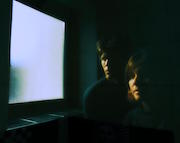When does musical improvisation become a jam? And when does a jam reach the heights of improvisation? It is a curious, yet rarely asked, question. Rock bands, you might say, jam. Jazz musicians improvise. But is there really so much difference?
Tomaga, aka percussionist Valentina Magaletti and bass player / electronicist Tom Relleen, cavort around this conundrum on The Shape of the Dance, their second full album. The duo may have started off as a self-styled “anti band” – a reaction to years operating as the percussion section in psych rock and punk acts that led them to ditch any trace of guitars – but there remains something of the primordial urge of rock and roll in their improvisational approach. This is improv music that rocks, rather than swings; improv that borrows more from krautrock and psych than classical and jazz.
It is also improv that, on The Shape of the Dance, is tight, compact and finely-tuned, with none of the flab of a jam band or musical flashery of improv jazz. The album was recorded in London and Italy, then edited down and compiled, and such care and attention pay dividend: The Shape of the Dance runs to eight tracks, most weighing in around the four-minute mark, and all shorn of unnecessary, aimless repetition. ‘Stone Comb’, for example, is a powerful, hypnotic beast, where not a second is wasted. The dread-filled tension builds horribly over the track’s two and a half minutes, with synth bloops and guest Rick Tomlinson’s cornet adding sickly layers to the furious shaking of a tambourine. Then, point made, the song stops on a dime.
The powerful tambourine on ‘Stone Comb’ illustrates another key theme to this album. The band’s sparse, rhythmic approach, stripping away the guitars and vocals we think of as a rock lead, foregrounds the tambourine’s strange percussive power on ‘Stone Comb’ and the result is a wonderful propulsive, impactful rhythm driven by the most unlikely of sources.
This idea – of the bare, propulsive force – returns time and again on The Shape of the Dance, an appropriate title for an album of near constant movement. ‘Tuscan Metalwork’, which opens the album, and the brilliant title track both ride frantically funky, ever evolving, percussive grooves, tapped out on whatever objects the band had to hand, over which they add drones, tones and rhythmic electronic quirks. Relleen recently told tQ that the band recorded a “huge amount of things” in the Tuscan landscape where the album was forged, including “metalwork, wasps, a tin of dried lentils, a wheelbarrow, springs, sacks of gravel” and this hands-on approach adds to the feeling of spontaneity that permeates The Shape of the Dance. Elsewhere, on ‘A Perspective With No End’, it is Relleen’s bass which drives proceedings, propelling the song along on a bass line that nods to the cutting simplicity of Joy Division.
The Shape of the Dance, then, is an album where rhythm largely lords it over melody. But that’s not to say there aren’t some beautiful melodic flashes: ‘A Perspective With No End’ has a delightfully simple vibraphone line, which teases the song’s wandering bass melody; while ‘Gonda’s Dream’ layers unsettling drones to create powerful, shifting chords. (Curiously, the songs with more musicians – like ‘Four Ducks Dead’, a collaboration with Florence based improv quintet Blutwurst – are among the least melodic.)
The result is an album that cements Tomaga’s curious, contradictory space in the musical sphere: a rock band based on improvisation that never succumbs to the jam; a percussion section that nods to psych rock yet shuns guitars and vocals; a musical output both casual yet tightly-bound. Band or anti band – whatever Tomaga may be – they are a marvellous example of their art.


